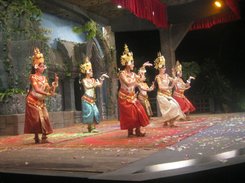
Traditional Khmer dance
By Derek Ray
The San Diego Reader
If you’re in Siem Reap, Cambodia, you’re most likely there to see the magnificent Angkor temples. But if you get “templed out” or have additional time, Siem Reap has more to offer.
Many of the locals don’t speak English, but I relished my interactions with those who did. The people I encountered seemed curious about America and were quite friendly. They charmed me as much as the accounts I was reading about the Khmer Rouge – the organization that terrorized the country in the 1970s – disgusted me.
While waiting for the ride to my hotel after my flight from Bangkok arrived in Siem Reap, I struck up a conversation with a young Cambodian who told me that many in his country had a personal stake in the outcome of the 2008 U.S. presidential election.
“We placed bets on the American election. Some people bet on Obama and some people bet on McCain. It was a big deal.”
He did not reveal whether more money had been placed on Obama or McCain.
My hotel driver finally arrived on a motorbike, the preferred mode of travel in Siem Reap – at least for locals. Tourists used to be able to rent motorbikes to see the temples. But after a local child was killed in an accident caused by a tourist on a motorbike, tourists were restricted to riding with local drivers.
As we rode along the river in Siem Reap, the poverty was apparent. Ramshackle hovels lined the area. Most of the population is quite poor and live on less than a dollar a day.
After arriving at my hotel, I walked along the river and struck up a conversation with a young man who was eager to practice his English. He introduced me to his family and told me about his dreams for the future, which included a trip to America.
I also enjoyed bantering with the staff at my hotel, who teased me about my affinity for banana pancakes for breakfast. I did try the traditional Cambodian breakfast of noodle soup. It was good, but a huge difference from what I'm used to at breakfast. The lemon tea that I began my mornings with was magnificent.
The tuk tuk ride to the Banteay Srei temple was an interesting and refreshing one. The temple was about 30 km away from my guesthouse in Siem Reap and required driving through some local villages and along rice fields. I was able to catch a glimpse of the lives of the people in the village as they began their daily routines.
We left a little after six, and the air was cool and moist. Along the way I watched multiple generations of families sitting in front of their thatched huts, relaxing in the stillness of the morning. They clearly enjoyed their moments together as children, ducks and dogs ran about and elders observed. Many of the homes I saw were raised on wooden legs as protection against flooding.
As we drove alongside the rice fields, I saw children in their school uniforms pause to make friends with a water buffalo. I saw men and women carrying impressive loads of goods and/or people on the backs and sides of their bicycles or motorcycles. Most Cambodians use these means of transport rather than cars and can be quite creative in the methods by which they transport various items or family members – including infants.
I saw a few people working in the rice paddies, some with water buffalo. My driver said that fifteen years ago many more people would have been working in the fields, but most of the villagers now rely on tourism for their income.
I asked my driver why some children seemed to be going to school while others were not. He told me that some go to school in the morning while others go in the afternoon to decrease crowding.
Visitors to Cambodia can take tours of the villages and visit schools if they’d like to meet the local people and experience more of an inside look at their lives. If you want to do a good deed for the local children while you’re here, you can donate blood to the Angkor Hospital for Children. You can also volunteer with one of the local NGOs.
On the way back from the temple, we stopped by the Cambodian Landmine Museum. It was founded by Aki Ra, a man who had placed many mines as a child when he worked for the Khmer Rouge. The KR killed his parents and he defected from them, devoting his life to helping remove land mines from Cambodia. Ra estimates that he has removed about 50,000 land mines.
An estimated six million land mines remain in Cambodia, so his work is far from over. Ra was selected one of CNN's 10 Heroes of 2010.
My driver told me about a wonderful show of traditional Khmer dances that was being held near my hotel. I jumped on the opportunity to attend, and was enchanted by the grace of the performances and the beauty of the presentation. They provided quite an interesting contrast to the dances I’d later see in Bali.
From Siem Reap you can also take a scenic boat ride to Battambang or make your way up to Phnom Penh, the capital of Cambodia, about five hours away. No matter your itinerary, be sure to include some encounters with the locals. It will greatly enrich your trip.

No comments:
Post a Comment